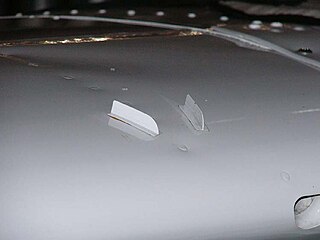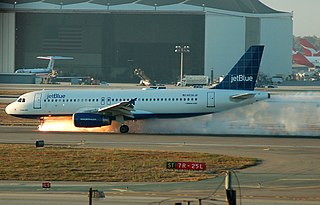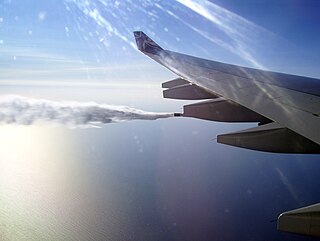Related Research Articles

The Tupolev Tu-144 is a Soviet supersonic passenger airliner designed by Tupolev in operation from 1968 to 1999.

The Tupolev Tu-114 Rossiya is a retired large turboprop-powered long-range airliner designed by the Tupolev design bureau and built in the Soviet Union from May 1955. The aircraft was the largest and fastest passenger plane at that time and also had the longest range, at 10,900 km (6,800 mi). It has held the official title of fastest propeller-driven aircraft since 1960.

The Tupolev Tu-134 is a twin-engined, narrow-body jet airliner built in the Soviet Union for short and medium-haul routes from 1966 to 1989. The original version featured a glazed-nose design and, like certain other Russian airliners, it can operate from unpaved airfields.

The Ilyushin Il-62 is a Soviet long-range narrow-body jetliner conceived in 1960 by Ilyushin. As a successor to the popular turboprop Il-18 and with capacity for almost 200 passengers and crew, the Il-62 was the world's largest jet airliner when first flown in 1963. The seventh quad-engined, long-range jet airliner to fly, it was the first such type to be operated by the Soviet Union and a number of allied nations.

The Tupolev Tu-104 is a medium-range, narrow-body, twin turbojet-powered Soviet airliner. It was the second to enter regular service, behind the British de Havilland Comet and was the only jetliner operating in the world from 1956 to 1958, when the British jetliner was grounded due to safety concerns.

The Tupolev Tu-154 is a three-engined, medium-range, narrow-body airliner designed in the mid-1960s and manufactured by Tupolev. A workhorse of Soviet and (subsequently) Russian airlines for several decades, it carried half of all passengers flown by Aeroflot and its subsidiaries, remaining the standard domestic-route airliner of Russia and former Soviet states until the mid-2000s. It was exported to 17 non-Russian airlines and used as a head-of-state transport by the air forces of several countries.

A vortex generator (VG) is an aerodynamic device, consisting of a small vane usually attached to a lifting surface or a rotor blade of a wind turbine. VGs may also be attached to some part of an aerodynamic vehicle such as an aircraft fuselage or a car. When the airfoil or the body is in motion relative to the air, the VG creates a vortex, which, by removing some part of the slow-moving boundary layer in contact with the airfoil surface, delays local flow separation and aerodynamic stalling, thereby improving the effectiveness of wings and control surfaces, such as flaps, elevators, ailerons, and rudders.

The Tupolev Tu-124 is a 56-passenger short-range twin-jet airliner built in the Soviet Union. It was the Soviet Union's first operational airliner powered by turbofan engines.

The maximum takeoff weight (MTOW) or maximum gross takeoff weight (MGTOW) or maximum takeoff mass (MTOM) of an aircraft, also known as the maximum structural takeoff weight or maximum structural takeoff mass, is the maximum weight at which the pilot is allowed to attempt to take off, due to structural or other limits. The analogous term for rockets is gross lift-off mass, or GLOW. MTOW is usually specified in units of kilograms or pounds.

An emergency landing is a premature landing made by an aircraft in response to an emergency involving an imminent or ongoing threat to the safety and operation of the aircraft, or involving a sudden need for a passenger or crew on board to terminate the flight. It typically involves a forced diversion to the nearest or most suitable airport or airbase, or an off airport landing or ditching if the flight cannot reach an airfield. Flights under air traffic control will be given priority over all other aircraft operations upon the declaration of the emergency.

Fuel dumping is a procedure used by aircraft in certain emergency situations before a return to the airport shortly after takeoff, or before landing short of the intended destination to reduce the aircraft's weight.
The center of gravity (CG) of an aircraft is the point over which the aircraft would balance. Its position is calculated after supporting the aircraft on at least two sets of weighing scales or load cells and noting the weight shown on each set of scales or load cells. The center of gravity affects the stability of the aircraft. To ensure the aircraft is safe to fly, the center of gravity must fall within specified limits established by the aircraft manufacturer.

LOT Polish Airlines Flight 5055 was a scheduled international passenger flight from Warsaw to New York City. In the late-morning hours of 9 May 1987, the Ilyushin Il-62M operating the flight crashed in the Kabaty Woods nature reserve on the outskirts of Warsaw around 56 minutes after departure. All 183 passengers and crew on board were killed in the crash, making it the deadliest accident involving an Ilyushin Il-62, and the deadliest aviation disaster in Polish history.
The aircraft gross weight is the total aircraft weight at any moment during the flight or ground operation.

The 1972 Puerto Rico DC-7 crash was an aviation accident that occurred on December 31, 1972, in Carolina, Puerto Rico. As a result of inadequate maintenance, the aircraft's No. 2 engine failed after takeoff. After initiating a turn to return to the airport, the aircraft eventually descended into, or attempted to ditch into, the ocean a mile offshore. All five people on board died, including baseball legend Roberto Clemente. The crash site was listed on the US National Register of Historic Places in 2022.

Aeroflot Flight 5003 was a Soviet domestic cargo flight that crashed during climb out on 14 January 1967. The Antonov An-12B was flying between Novosibirsk and Krasnoyarsk in Russia with a crew of six when it crashed. It was carrying industrial parts from Moscow to Khabarovsk with several intermediate stops in between, however it caught fire shortly after takeoff, resulting in a fatal accident. At the time Flight 5003 was being operated by Polar Aviation Management under Aeroflot.

Aeroflot Flight 036 was a regularly scheduled passenger flight operated by Aeroflot from Cairo International Airport to Bykovo Airport. On 17 August 1960, the Ilyushin Il-18 operating this flight crashed after an engine fire. All 27 passengers and seven crew members were killed.

Aeroflot Flight 1492 was a scheduled domestic passenger flight operated by Aeroflot from Moscow–Sheremetyevo to Murmansk, Russia. On 5 May 2019, the Sukhoi Superjet 100 aircraft operating the flight was climbing out when it was struck by lightning. The aircraft suffered an electrical failure and returned to Sheremetyevo for an emergency landing. It bounced on landing and touched down hard, causing the landing gear to collapse, fuel to spill out of the wings, and a fire to erupt. The fire engulfed the rear of the aircraft, killing 41 of the 78 occupants.
In aviation, a bounced landing is a behavior of an aircraft that can develop after aircraft touching the runway or water surface, and defined as all aircraft wheels or floats briefly and sometimes repeatedly losing contact with the runway or water surface during landing.

Delta Air Lines Flight 89 was a scheduled flight from Los Angeles International Airport to Shanghai Pudong International Airport. On January 14, 2020, the Boeing 777-232ER conducting the flight had engine problems shortly after takeoff; while returning to the origin airport for an emergency landing, it dumped fuel over populated areas adjacent to the city of Los Angeles, resulting in skin and lung irritation in at least 56 people on the ground and triggering a Federal Aviation Administration (FAA) investigation. The aircraft landed safely with no injuries to passengers or crew.
References
- ↑ "JAR-OPS 1.607 (c)" (PDF). Retrieved 28 October 2024.
- 1 2 3 "Desperate Escape | Crashing Just After Landing in Moscow | Aeroflot Flight 1492". The Flight Channel. 22 October 2020. Archived from the original on 15 December 2021. Retrieved 27 October 2020.
- 1 2 Redmond Shannon (3 February 2020). "Air Canada flight forced to make emergency landing in Madrid". Global News . Archived from the original on 15 December 2021. Retrieved 15 October 2020.
- ↑ Travis Fedschun (16 April 2020). "Moscow plane crash: New video emerges of fatal accident in Russia". News.com.au. Retrieved 27 October 2020.